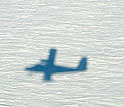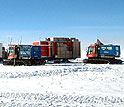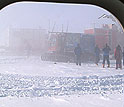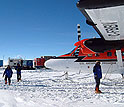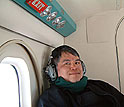News Release 05-006
Chinese Engineer Receives Medical Treatment After Falling Ill During Antarctic Traverse
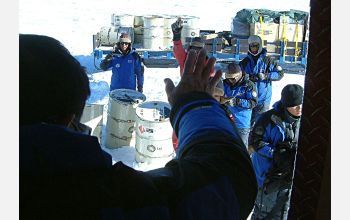
The patient waves as he prepares to leave for NSF's Amundsen-Scott South Pole Station.
January 19, 2005
This material is available primarily for archival purposes. Telephone numbers or other contact information may be out of date; please see current contact information at media contacts.
ARLINGTON, VA.—A Chinese engineer who became seriously ill while crossing East Antarctica for his nation as part of a scientific traverse is resting comfortably in New Zealand today after a U.S. aircraft flew him to the National Science Foundation's Amundsen-Scott South Pole Station for medical treatment.
The 49-year-old hydraulics engineer, whose identity is being kept confidential, began experiencing chest pains on Jan. 7, after climbing to the roof of a Chinese traverse vehicle to perform a task the night before, according to Jihong Cole-Dai, a Mandarin-speaking U.S. glaciologist who was working at the South Pole. Cole-Dai, of South Dakota State University, served as an interpreter during the medical mission.
According to Chinese officials, as interpreted by Cole-Dai, the patient awoke on Jan. 7 feeling weak and unwell, and experiencing chest pains, which recurred throughout the day.
The patient is a member of the 21st Chinese National Antarctic Research Expedition (CHINAIRE) traverse team, which left China's Zhongshan Station on Dec. 12 on an expedition marking the first human attempt to scale Dome Argus, an ice-covered mountain roughly 650 nautical miles (740 miles) from the South Pole, according to Chinese officials. The expedition was also laying the groundwork for selecting a location for a new Chinese Antarctic research station.
The traverse team was at Dome Argus at roughly 4022 meters (13,000 feet) elevation when the engineer became ill. Physicians became concerned that the patient might be suffering from severe and potentially fatal complications of altitude sickness.
On Jan. 7, local time, CHINAIRE officials formally requested the U.S. Antarctic Program to send an aircraft to evacuate the ailing engineer. NSF manages the U.S. Antarctic Program.
A Twin Otter aircraft flown by Kenn Borek Air, Ltd., of Canada, chartered by NSF for scientific work, left the South Pole at approximately 9 a.m. on Jan. 8 for the four-hour flight to Dome Argus. In addition to the pilot and co-pilot, the plane carried Christian Otto, one of two South Pole physicians, and interpreter Cole-Dai.
Working with traverse leader, Li Yuansheng, and the traverse physician, Dr. Hexiang Tong, Otto assisted in stabilizing the patient's condition for the return flight to the South Pole. An EKG monitored the patient's condition during the flight. The plane arrived at the Pole at approximately 6:30 p.m. (local) on Jan. 8.
The patient was treated and kept comfortable at the Pole, then transported on a flight to McMurdo Station, NSF's logistics hub in Antarctica. The patient remained stable and was flown to New Zealand, arriving in Christchurch on the morning of Jan. 17.
A more complete diagnosis of the patient's condition will be made in Christchurch. Otto reported that ailing engineer did not seem to be suffering from high-altitude pulmonary edema.
U.S. flights from the continent depart McMurdo Station daily, but bad weather at the station grounded all flights for several days, making it impossible for a medical flight to take the patient back to New Zealand.
-NSF-
-
The Twin Otter aircraft used in the medevac casts its shadow on the Antarctic ice sheet.
Credit and Larger Version -
Vehicles of the 21st CHINAIRE traverse team.
Credit and Larger Version -
Members of the 21st CHINAIRE traverse team.
Credit and Larger Version -
A U.S. Antartcic Program Twin Otter on the ground at Dome Argus.
Credit and Larger Version -
Jihong Cole-Dai, a U.S glaciologist acted as a translator during the medical mission.
Credit and Larger Version
Media Contacts
Dena Headlee, NSF, (703) 292-8070, email: dheadlee@nsf.gov
The U.S. National Science Foundation propels the nation forward by advancing fundamental research in all fields of science and engineering. NSF supports research and people by providing facilities, instruments and funding to support their ingenuity and sustain the U.S. as a global leader in research and innovation. With a fiscal year 2023 budget of $9.5 billion, NSF funds reach all 50 states through grants to nearly 2,000 colleges, universities and institutions. Each year, NSF receives more than 40,000 competitive proposals and makes about 11,000 new awards. Those awards include support for cooperative research with industry, Arctic and Antarctic research and operations, and U.S. participation in international scientific efforts.
Connect with us online
NSF website: nsf.gov
NSF News: nsf.gov/news
For News Media: nsf.gov/news/newsroom
Statistics: nsf.gov/statistics/
Awards database: nsf.gov/awardsearch/
Follow us on social
Twitter: twitter.com/NSF
Facebook: facebook.com/US.NSF
Instagram: instagram.com/nsfgov



